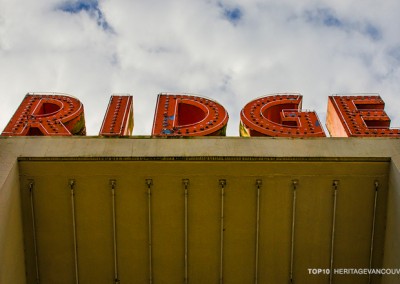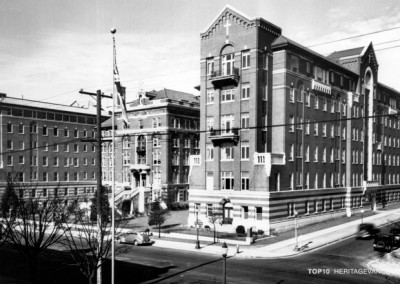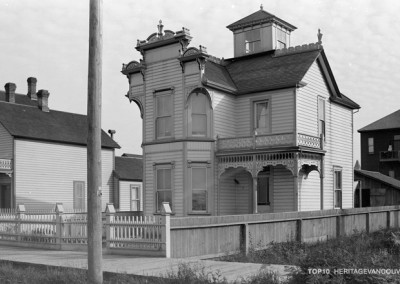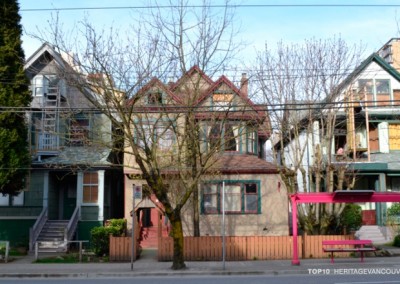The unique, low-scale character of the historic Granville streetscape continues to be threatened from development pressures and a desire to “clean up” the area. A number of Victorian and Edwardian buildings are up for sale.
The current zoning, which was designed to retain lower heights and density along the street, is being eroded in the wake of recent City approvals of spot zoning for affordable housing.
Threat
What is the threat to downtown Granville Street?
Post-war prosperity in Vancouver led to the construction of the new Granville Street Bridge. Although the bridge provided a gateway to the area, diversion of traffic onto Howe and Seymour Streets had an adverse impact on retail activity along Granville. The end of streetcar service in the 1950s also contributed to the area’s decline.
In the 1960s, the Pacific Centre Mall was constructed and Granville Street between Nelson and Hastings became a pedestrian mall. This was meant to increase foot traffic. Unfortunately, as the Pacific Centre Mall flourished, businesses on Granville Street closed and the area began to suffer from disinvestment. There has been a gradual but steady decline in socio-economic conditions and physical decay leading to calls for large-scale redevelopment to “clean up” the south end of the street. If this occurs, the unique, historic streetscape could disappear to be replaced by high-rise towers.
In the early 1990s, downtown Granville Street was downzoned to protect its historic building stock and low-scale ‘saw tooth’ skyline. The intention was to trade off height and density by upzoning Downtown South. Some significant one and two-storey buildings, such as the historic theatres, are well below the allowable density of 3.5 FSR (floor space ratio). City policies such as the Short Term Incentives for Rental Housing (STIR), which allows for spot density increases, has put pressure on existing buildings. One current STIR project on Granville Street has resulted in a building that is over the 90-foot height limit and almost twice the allowable density.
Many buildings that define the character of the 800-1200 blocks of Granville Street are not on the Vancouver Heritage Register. This collection of buildings was listed on Heritage Vancouver’s 2011 Top Ten Endangered Sites. For example only two Italianate buildings, the Yale Hotel and the Vermilyea Block are listed, while the Holman Block and the Keith Block are not. Without any formal heritage recognition of these buildings, it is only a matter of time before development pressure leads to demolition, and loss of the street’s irreplaceable character.
In February 2012, 801-809 Granville/700-720 Robson Street (The Farmer Building, Maclure & Lort, Architects, 1922), a building not listed on the Heritage Register, was demolished.
Lastly, the significant building interiors along Granville Street, including the remarkable Commodore Ballroom and the Orpheum and Vogue Theatres, are not legally protected, and could be radically altered. Another historic building with a significant interior, the Templeton Restaurant at 1087 Granville Street, is not even listed on the Heritage Register.
The City of Vancouver has few incentives to offer building owners to help defray the costs of exterior alterations and interior renovations. The City’s Heritage Density bank is frozen, and incentives such as façade grants and property tax relief that are available for the Gastown and Chinatown Historic Areas are not applicable to Granville Street. We are at a critical point where Vancouverites will see much of Granville’s historic streetscape disappear unless it is recognized as an invaluable asset to be conserved, and revitalized.
Significance
Why is downtown Granville Street significant?
Growth in the downtown core was rapid following the Great Fire of 1886, and a number of new permanent buildings were built by 1889. That year, the original Granville Street Bridge was finished to provide access to emerging suburbs to the south. In 1890, the first lines of an electric streetcar system were laid on Hastings, Main and Granville Streets, which was a catalyst for a commercial and housing boom.
It was during the Edwardian era that Granville Street gained significance as a business centre. The architectural firm of Parr & Fee held extensive lands on Granville Street at this time, and designed and developed a number of large apartment hotels in a cohesive style that gives the street its character. After World War I, prohibition forced the closing of local saloons, making hotels less profitable. Stagnation left a mix of densely developed sites next to one-storey buildings and vacant sites, resulting in a “saw tooth” skyline and street profile, not radically altered since 1913.
Granville Street was also established as Vancouver’s theatre district early in the city’s history, and several older theatres were replaced by larger, more modern structures. Neon signs were large and ubiquitous. Granville Street became known as the ‘Street of Lights’, where storefront signs competed with theatres in size and character. The growing wealth of the 1920s was manifest in construction of more and larger theatres and entertainment halls including the Commodore Cabaret nightclub later in the decade. Renewed building activity ended with the Great Depression in 1929. Another wave of development came and lasted briefly until 1939. There has been very little building activity post-World War II, until recently, which has resulted in some demolitions and redevelopment.
Position
Heritage Vancouver’s Position
Heritage Vancouver supports the preservation and revitalization of the unique character of historic Granville Street. Despite its decline, the streetscape has a striking ensemble of significant buildings that tell an important story of the early development of the city centre. With heritage-led revitalization, Downtown’s Granville Street would once again take its place as one of Vancouver’s great streets.
This can only be accomplished by formally protecting historic buildings that are on the Heritage Register, as well as recognizing those historic sites that are not yet listed. It is unlikely that these structures will be retained without heritage designation or offering of significant incentives, regardless of the relatively low allowable densities of the existing zoning.
In recognition of the historic importance of this area of Granville Street, Heritage Vancouver recommends that the City of Vancouver:
- Initiate a comprehensive heritage and urban design study of the 800-1200 blocks of Granville Street to retain and enhance the invaluable historic resources that define the street’s character.
- Work with the community to undertake a full review of heritage incentives that could be used to conserve this historic building stock, such as density transfers, property tax relief and grants.
- Include – at a minimum – the following buildings on the Vancouver Heritage Register, most urgently two very significant 1888-89 Victorian Italianate brick structures: the Holman Block, 1202-04 Granville Street and the Keith Block, 1294 Granville Street.
Key buildings which should be added to the Vancouver Heritage Register:
812-816 Granville Street
Allen Building; Braunton & Leibert, Architects; 1914
800-804 Granville Street, at Robson (SE corner)
Townley & Matheson, Architects; 1922*
*(Building permits A-3385; A-3686; T&M job card #103)
801-809 Granville / 700-720 Robson Street [demolished Feb 2012]
The Farmer Building; Maclure & Lort, Architects; 1922
881 Granville Street
The Plaza Theatre, now Venue; Thomas L. Kerr, Architect; 1936
901-909 Granville Street
The Gresham Hotel; 1908
917-919 Granville Street
The Studio Theatre, now Tonic; H.H. Simmonds, Architect; 1948
1001-1019 Granville Street
Jermaine’s Ladies Wear; Ross A. Lort, Architect; 1931
1002-1006 Granville Street
Hotel Barron (1912-1925); later The Belmont Hotel (1926-1970), now the Comfort Inn (1971 To Present); Parr & Fee, Architects; 1910-1911
1087 Granville Street
Originally Adele’s Coffee Shop, now the Templeton Restauran; circa 1934
1160-1176 Granville Street
Hotel Martinique, now Howard Johnson’s; Parr & Fee, Architects; 1906
1202-1204 Granville Street
Holman Block/Golden Gate Hotel, later the Hotel Tourist; 1888-1889
1294 Granville Street / 677 Drake Street
Keith Block; Noble Stonestreet Hoffar, Architect; 1888-1889





![4. Schools: Sir James Douglas Elementary (1910-12) [lost]](http://heritagevancouver.org/wp-content/uploads/2012/08/t10-school-douglas-795-400x284.jpg)




